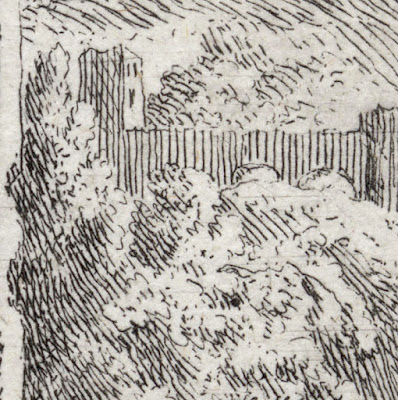Johann Elias Ridinger (aka Johann Elias Riedinger) (1698–1767)
Two tondo
scenes featuring ruins after Johann
Heinrich Roos (1631-85), c.1730s, from the series, “Mammals after Roos”, published
in Augsburg by Johann
Friedrich Probst (1721–81).
Etchings on laid
paper trimmed unevenly and lined on conservator’s support sheets.
Size of left
print: (sheet) 24.4 x 28.4 cm
Size of right
print: (sheet) 24 x 24.4 cm
Each print is lettered in two
lines with production and publication details below the circular borderline: “Ioh.
Heinrich Ros inv et del, Cum Priv..Sac.Caes,.Maj, / Ioh. Elias Riedinger
Sculps, Aquae forti Reg: ½. Fol. No. 6. Ioh: Frid: Probst, Haered. Ier. Wolffy
excud. Aug..V.´
Other prints
from the same series may be seen at the British Museum:
Thienemann 1856
undescribed (Thienemann, Georg, Leben und Wirken des ... Thiermalers und
Kupferstechers Johann Elias Ridinger, mit ... Verzeichniss seiner Kupferstiche,
Schwarzkunstblätter, Leipzig, Rudolph Weigel, 1856)
Condition: rich
and well-printed impressions, trimmed unevenly with some sides still intact
with the platemarks. Both prints have been laid down on conservator’s support
sheets. Beyond the issue of the uneven edges (somewhat rectified by the prints having been lined on support sheets) the prints are in reasonably good
condition, but the print shown on the left has an abrasion at the lower left and
the print shown on the right has a few minor marks. The print shown on the left has a wide left margin
with a faded and curiously interesting ink notation by an old hand.
I am selling this
pair of marvellous early 18th century etchings for AU$230 (currently
US$171.07/EUR159.85/GBP134.48 at the time of this listing) including postage
and handling to anywhere in the world. If you are interested in purchasing two
exceptional prints, please contact me (oz_jim@printsandprinciples.com) and I
will send you a PayPal invoice to make the payment easy.
These prints have been sold
The term “tondo”
(the plural is “tondi”) are round compositions designed to be independent of
other images. In paintings the term is usually reserved to describe a work
larger than 60 cms, but with prints and sculptures this determining factor is
not relevant—or not as relevant (see “The Art Bulletin”, Vol. 83, No. 2, June
2001, p. 349).
One attribute
that is commonly found in tondi compositions is that they are
invariably presented contained within a square shape, as seen in this pair of
prints. One reason is for this arrangement is a straightforward and practical:
a square is easier to frame than a circle. Another reason is that a circle is
more difficult to cut as a printing plate than is a square. Beyond these
technical advantages, a square picture hung on a wall is more likely to be in
accord (i.e. “fit in”) with rectangular shaped artworks along with the
perpendiculars and horizontals of surrounding architecture.
What I find interesting
about this “squaring” of the circular format (i.e. framing a tondo within a
square) is that this arrangement lends the suggestion of dynamism to the
circular image. By this I mean that a tondo composition appears to have more
rhythmic life and pictorial vitality when it is framed within a square by
virtue of a viewer perceiving contrast—perhaps subliminally—between the calm
and stable shape of a square abutting the constantly revolving energy of the
tondo’s round shape.










No comments:
Post a Comment
Please let me know your thoughts, advice about inaccuracies (including typos) and additional information that you would like to add to any post.